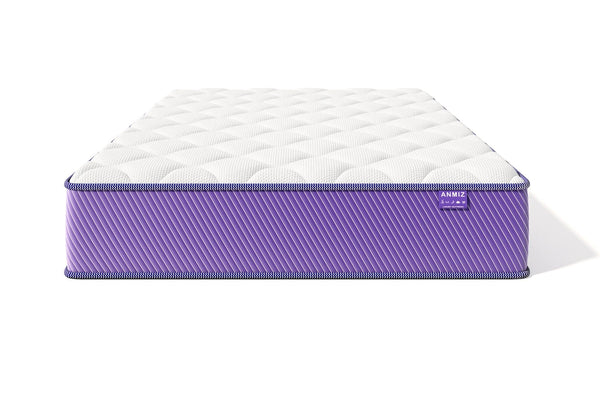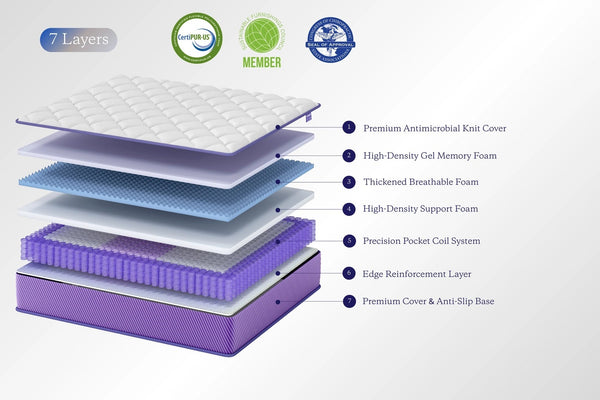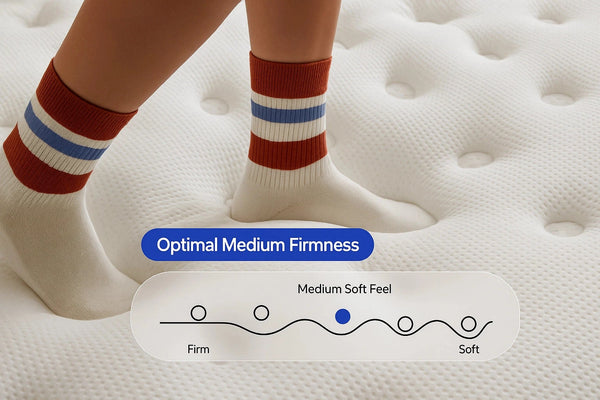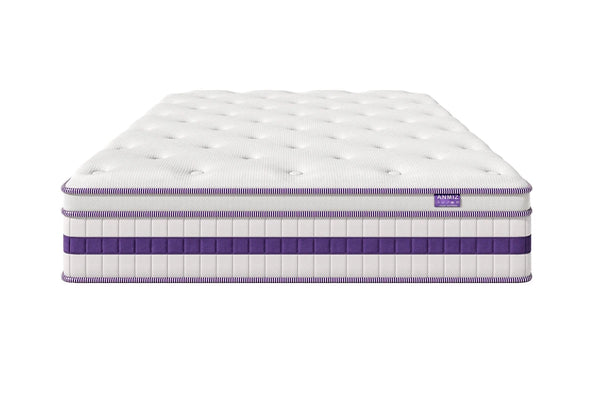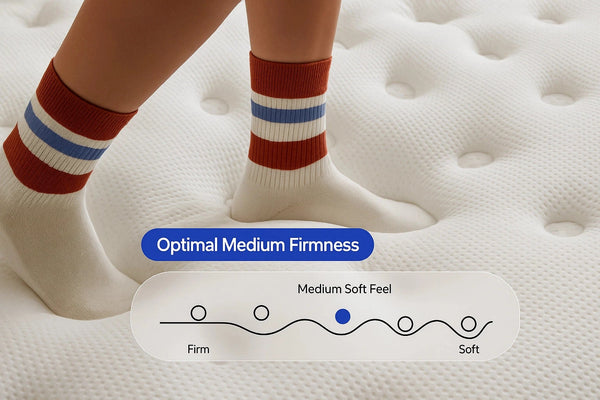Suffering from back pain? A good mattress back pain solution might be closer than you think. The right mattress can significantly reduce discomfort while enhancing sleep quality.
Why Does a Mattress Matter for Back Pain?
How Your Mattress Affects Spine Health
Did you know your mattress isn't just for comfort, but also crucial for keeping your spine healthy? When you're asleep, your mattress supports your spine's natural curves. If it's too soft, your spine might sink unevenly, creating tension and pain. Conversely, if your mattress is excessively firm, it may not provide adequate cushioning, leading to uncomfortable pressure points. Studies have shown that sleeping on an unsupportive mattress can worsen back issues, causing increased stiffness, soreness, and disrupted sleep. Choosing the right mattress is essential—it helps your muscles relax properly overnight, preventing strain and reducing the likelihood of waking up in pain.
A supportive mattress is like a reliable teammate for your back—it supports your spine gently yet firmly, ensuring it stays aligned. So, if you're experiencing persistent back pain, taking a closer look at your mattress could lead to significant relief.
Signs Your Mattress Might Be Hurting Your Back
Are you waking up feeling worse than when you went to bed? Here are some signs that your mattress might be causing your back problems:
- Visible sagging or lumps: Indicates worn-out support, leading to improper spine alignment.
- Tossing and turning frequently: Suggests your body is uncomfortable and struggling to find the right sleeping position.
- Feeling better when sleeping elsewhere: Clear sign your mattress is negatively impacting your sleep quality.
Recognizing these clues early can help you replace your mattress before it worsens your discomfort.
The Science Behind Spinal Alignment and Mattresses
Why Spinal Alignment Matters
Your spine is happiest when it stays straight. Proper alignment reduces pressure on sensitive areas like your hips, shoulders, and lower back. When your mattress supports the natural curve of your spine, muscles surrounding it can relax fully, reducing tension overnight. Misalignment means muscles work harder, trying to balance your body during sleep, leading to stiffness and pain when you wake up. It's like holding a heavy bag all day—eventually, your muscles tire out and ache. A mattress that aligns your spine evenly prevents this kind of unnecessary strain.
Think of it like balancing a book on your head; if it stays steady, everything feels comfortable, but if it tilts, your body quickly becomes tense and uncomfortable.
Real-Life Benefits of Proper Alignment
Imagine waking up refreshed and free from pain, ready for the day ahead. This is the reality when you choose a mattress that supports proper alignment. Studies suggest people who sleep on correctly aligned mattresses report less chronic back pain, higher energy levels, and better overall quality of life. Good sleep boosts your mood, improves concentration, and even enhances your body's healing capabilities. Why wouldn't you give yourself that advantage?
So, yes, your mattress matters—a lot more than you might think.
What Makes the Best Mattress for Back Pain?
Understanding Firmness Levels
The ideal mattress firmness for back pain sufferers isn't universal—it's usually a medium-firm mattress. A mattress that's too soft allows your body to sink too deeply, causing misalignment and pain. On the flip side, an overly firm mattress won't conform to your body shape, creating uncomfortable pressure points. Medium-firm mattresses offer a balanced blend of support and comfort, easing pressure on critical points like your hips and shoulders while keeping your spine aligned properly.
Finding this "sweet spot" makes all the difference, providing both restful sleep and relief from back pain.
Best Mattress Materials for Back Pain Relief
Not all mattresses are created equal. Some materials are more effective at easing back pain. Here's what you should consider:
- Memory Foam: It contours perfectly to your body shape, significantly reducing pressure points. It’s especially beneficial for those experiencing chronic back pain.
- Latex: Offers a supportive, springy feel that keeps you cool while providing durability.
- Hybrid Mattresses: Combines foam layers with innerspring coils, delivering the perfect balance of comfort, support, and breathability.
Experimenting with different mattress materials can help you find your perfect fit.
Choosing Based on Your Sleep Position
Best Mattresses for Side Sleepers
Do you primarily sleep on your side? If so, choosing a slightly softer mattress can dramatically reduce pain. Side sleepers need cushioning at the hips and shoulders to alleviate pressure points. Memory foam mattresses are particularly effective because they mold gently around these areas, preventing soreness and stiffness when you wake up.
Think of it as giving your body a comforting hug all night, easing pressure and pain naturally.
Perfect Mattresses for Back Sleepers
Back sleepers require extra support to maintain spinal alignment, especially under the lower back. Medium-firm hybrid mattresses are ideal for this sleep style. They evenly distribute weight and provide consistent support throughout the night, significantly reducing discomfort and stiffness in the morning.
It's the equivalent of having the perfect foundation supporting your body, ensuring a restful and pain-free sleep.
Tips for Testing and Buying Your Mattress
How to Properly Test Your Mattress
Buying a mattress isn't a quick decision. Spend plenty of time trying different options in-store, or consider brands offering long-term home trials. Five minutes lying down isn't enough; you need several nights or even weeks to assess comfort accurately. Pay attention to how your body feels each morning, noting changes in your pain levels and overall sleep quality.
Remember, a short test won’t reveal a mattress's true potential—take your time to ensure the best investment for your health.
Consider Longevity and Investment
A quality mattress might cost more initially, but it pays off long-term in improved health and fewer replacements. Most mattresses have a lifespan of about 7–10 years. Here's a quick comparison:
| Mattress Type | Average Lifespan | Comfort Level for Back Pain |
|---|---|---|
| Memory Foam | 8-10 years | High |
| Latex | 10-12 years | Very High |
| Hybrid | 7-9 years | High |
Additional Strategies for Reducing Back Pain
Choosing the Right Pillow
A mattress alone might not solve all your pain issues—your pillow matters too. For side sleepers, placing a pillow between your knees helps stabilize your hips and spine. Back sleepers benefit from a supportive pillow under their neck and knees to reduce spinal strain.
Don’t overlook your pillow; it could be the secret ingredient to your pain-free sleep recipe!
Managing Sleep Temperature
Did you know temperature impacts your sleep quality? Opting for breathable mattress materials, like gel-infused memory foam or latex, prevents overheating. Overheating can lead to restless sleep, which worsens muscle tension and back pain.
Keeping cool at night isn't just comfortable—it’s essential for managing back pain effectively.
Conclusion: Enhance Your Sleep, Ease Your Pain
A good mattress designed for back pain isn't just a comfort choice; it's a health decision. Consider firmness, materials, and your sleep position carefully. When you choose thoughtfully, your mattress can transform your nights, reducing pain and improving your daily life.
Don't settle for pain—choose wisely and sleep comfortably!

